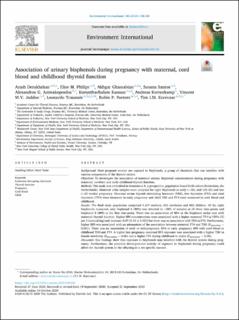| dc.contributor.author | Derakhshan, Arash | |
| dc.contributor.author | Philips, Elise M. | |
| dc.contributor.author | Akhgar, Ghassabian | |
| dc.contributor.author | Santos, Susana | |
| dc.contributor.author | Asimakopoulos, Alexandros | |
| dc.contributor.author | Kannan, Kurunthachalam | |
| dc.contributor.author | Kortenkamp, Andreas | |
| dc.contributor.author | Jaddoe, Vincent V.W. | |
| dc.contributor.author | Trasande, Leonardo | |
| dc.contributor.author | Peeters, Robin P. | |
| dc.contributor.author | Korevaar, Tim | |
| dc.date.accessioned | 2022-11-22T07:38:14Z | |
| dc.date.available | 2022-11-22T07:38:14Z | |
| dc.date.created | 2021-01-19T21:51:28Z | |
| dc.date.issued | 2021 | |
| dc.identifier.citation | Environment International. 2021, 146 . | en_US |
| dc.identifier.issn | 0160-4120 | |
| dc.identifier.uri | https://hdl.handle.net/11250/3033237 | |
| dc.description.abstract | Background
Most pregnant women are exposed to bisphenols, a group of chemicals that can interfere with various components of the thyroid system.
Objectives
To investigate the association of maternal urinary bisphenol concentrations during pregnancy with maternal, newborn and early childhood thyroid function.
Methods
This study was embedded in Generation R, a prospective, population-based birth cohort (Rotterdam, the Netherlands). Maternal urine samples were analyzed for eight bisphenols at early (<18), mid (18–25) and late (>25 weeks) pregnancy. Maternal serum thyroid stimulating hormone (TSH), free thyroxine (FT4) and total thyroxine (TT4) were measured in early pregnancy and child TSH and FT4 were measured in cord blood and childhood.
Results
The final study population comprised 1,267 mothers, 853 newborns and 882 children. Of the eight bisphenols measured, only bisphenol A (BPA) was detected in >50% of samples at all three time-points and bisphenol S (BPS) at the first time-point. There was no association of BPA or the bisphenol molar sum with maternal thyroid function. Higher BPS concentrations were associated with a higher maternal TT4 (β [95% CI] per 1 (natural-log) unit increase: 0.97 [0.03 to 1.91]) but there was no association with TSH or FT4. Furthermore, higher BPS was associated with an attenuation of the association between maternal FT4 and TSH (Pinteraction = 0.001). There was no association of early or mid-pregnancy BPA or early pregnancy BPS with cord blood or childhood TSH and FT4. A higher late pregnancy maternal BPA exposure was associated with a higher TSH in female newborns (Pinteraction = 0.06) and a higher FT4 during childhood in males (Pinteraction = 0.08).
Discussion
Our findings show that exposure to bisphenols may interfere with the thyroid system during pregnancy. Furthermore, the potential developmental toxicity of exposure to bisphenols during pregnancy could affect the thyroid system in the offspring in a sex-specific manner. | en_US |
| dc.language.iso | eng | en_US |
| dc.publisher | Elsevier | en_US |
| dc.rights | Navngivelse 4.0 Internasjonal | * |
| dc.rights.uri | http://creativecommons.org/licenses/by/4.0/deed.no | * |
| dc.title | Association of urinary bisphenols during pregnancy with maternal, cord blood and childhood thyroid function | en_US |
| dc.title.alternative | Association of urinary bisphenols during pregnancy with maternal, cord blood and childhood thyroid function | en_US |
| dc.type | Peer reviewed | en_US |
| dc.type | Journal article | en_US |
| dc.description.version | publishedVersion | en_US |
| dc.source.pagenumber | 8 | en_US |
| dc.source.volume | 146 | en_US |
| dc.source.journal | Environment International | en_US |
| dc.identifier.doi | 10.1016/j.envint.2020.106160 | |
| dc.identifier.cristin | 1874960 | |
| cristin.ispublished | true | |
| cristin.fulltext | original | |
| cristin.qualitycode | 1 | |

